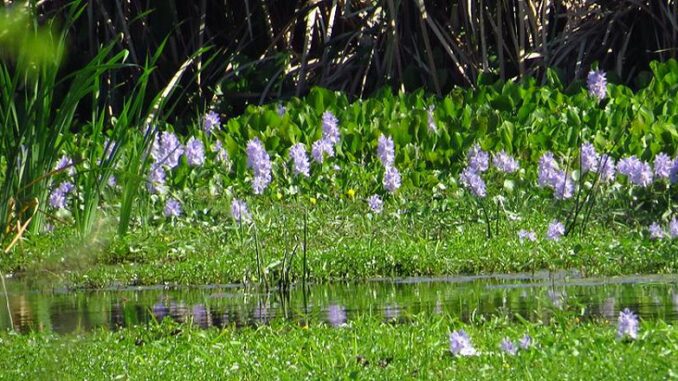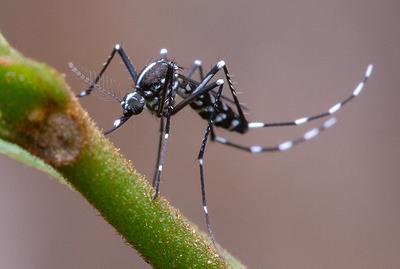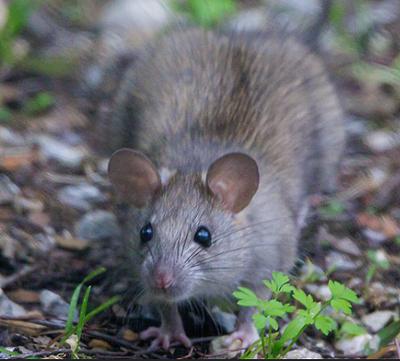
BONN, Germany, September 5, 2023 (ENS) – Invasive alien species pose a “severe global threat that is underappreciated, underestimated, and often unacknowledged,” finds a new report by the Intergovernmental Platform on Biodiversity and Ecosystem Services, IPBES, an independent intergovernmental body working to strengthen the role of science in public decision-making.
Established in 2012, the IPBES is open to all member countries of the United Nations; Palau joined this summer as its 143rd member.
Delegates of the 143 IPBES member States meeting in Bonn, approved the “Assessment Report on Invasive Alien Species and their Control” on Saturday.
The assessment finds that more than 37,000 alien species have been introduced by human activities throughout the world into regions and biomes – large areas of characteristic wildlife, vegetation, soil, and climate – where they are not native.
More than 3,500 of these are harmful invasive alien species that cause changes to native species and ecosystems, threatening the natural order and interfering with nature’s contributions to humanity and our “good quality of life,” the report finds, noting that this figure is now rising more quickly than ever before.
And this is a costly economic sinkhole of a challenge. Growing 400 percent in every decade since 1970, the global economic cost of invasive alien species topped $423 billion annually in 2019,
“Humanity has been moving species around the world for centuries. This practice has brought some positives. However, when imported species run rampant and unbalance local ecosystems, indigenous biodiversity suffers,” commented Inger Andersen, executive director, UN Environment Programme, UNEP.
“As a result, invasive species have become one of the five horsemen of the biodiversity apocalypse that is riding down harder and faster upon the world,” Andersen declared. “While the other four horsemen – changing land- and sea-use, over exploitation, climate change and pollution – are relatively well understood, knowledge gaps remain around invasive species.”
She called the IPBES Invasive Alien Species Report “a welcome effort to close these gaps. By providing critical information on trends in invasive species and policy tools to address them, this report can provide a springboard to concrete action on invasive species.”
Alarm Bells Rung in 2019 Assessment
In 2019, the IPBES Global Assessment Report found that invasive alien species are one of the five most important direct drivers of biodiversity loss – alongside changes in land- and sea-use, direct exploitation of species, climate change and pollution.
Alarmed by this finding, governments asked IPBES to provide the best available scientific evidence and policy options to deal with the challenges of biological invasions.
The resulting Invasive Alien Species report,” released Monday, was produced by 86 experts from 49 countries, working for more than four and a half years. It draws on more than 13,000 references, including what the authors call “very significant contributions from Indigenous Peoples and local communities, making it the most comprehensive assessment ever carried out of invasive alien species around the world.”
“Invasive alien species are a major threat to biodiversity and can cause irreversible damage to nature, including local and global species extinctions, and also threaten human wellbeing,” said Professor Helen Roy of the UK Centre for Ecology & Hydrology.

Dr. Roy co-chaired the Assessment with Professor Anibal Pauchard of Chile, a faculty member in Forestry Sciences at the University of Concepción; and Professor Peter Stoett of Canada, dean of the faculty of Social Science and Humanities at University of Ontario Institute of Technology.
The assessment emphasizes that not all alien species become invasive. Invasive alien species are the subset of alien species that become established and spread, causing negative impacts on nature and often also on people.
About six percent of alien plants; 22 percent of alien invertebrates; 14 percent of alien vertebrates; and 11 percent of alien microbes are known to be invasive, posing major risks to nature and to people.
People with the greatest direct dependence on nature, such as Indigenous Peoples and local communities, are found to be at even greater than average risk.
More than 2,300 invasive alien species are found on lands under the stewardship of Indigenous Peoples, threatening their quality of life and even cultural identities, the report finds.
While many alien species were historically introduced on purpose for their perceived benefits to people, the IPBES reports that the negative impacts of those species that do become invasive are enormous for nature and for people.

Dr. Pauchard says that “85 percent of the impacts of biological invasions on native species are negative,” pointing to the ways that North American beavers (Castor canadensis) “change ecosystems by transforming habitats – often with severe consequences for native species.”
Invasive aliens can cause deadly diseases among humans, he points out, such as the outbreaks of malaria, Zika and West Nile fever spread by invasive alien mosquito species like Aedes albopictus and Aedes aegyptii.
Also, invasive alien species can damage human food supplies, says Pauchard, citing the situation in Africa’s Lake Victoria where the spread of water hyacinth (Pontederia crassipes), the world’s most widespread terrestrial invasive alien species, has shut out the food fish tilapia.
10 Species Top Invasive Aliens List
Of the 10 most widespread invasive alien species, seven are plants, and just three are animals: the black rat (Rattus rattus); the house mouse (Mus musculus); and the brown rat (Rattus norvegicus) 48
Lantana (Lantana camara), a flowering shrub, is the second most widespread globally, and in third place is Leucaena leucocephala (leucaena), a small fast-growing mimosoid tree native to southern Mexico and northern Central America that has now spread throughout the tropics, including parts of Asia.
The plants Ricinus communis (castor bean), Ailanthus altissima (tree-of-heaven), Robinia pseudoacacia (black locust), and Chromolaena odorata (Siam weed) are spreading quickly enough to rank them in the top 10.
“It would be an extremely costly mistake to regard biological invasions only as someone else’s problem,” said Pauchard. “Although the specific species that inflict damages vary from place to place, these are risks and challenges with global roots but very local impacts, facing people in every country, from all backgrounds and in every community – even Antarctica is being affected.”
The IPBES report shows that 34 percent of the impacts of biological invasions were reported from the Americas, 31 percent from Europe and Central Asia, 25 percent from Asia and the Pacific region and about 7 percent from Africa.
Most negative impacts are reported on land (about 75 percent) – especially in forests, woodlands and cultivated areas – with considerably fewer reported in freshwater (14 percent) and marine (10 percent) habitats . Invasive alien species are most damaging on islands, with numbers of alien plants now exceeding the number of native plants on more than 25 percent of all islands.
Business as Usual Not Advised
“The future threat from invasive alien species is a major concern,” said Assessment co-chair Dr. Roy. “Thirty-seven percent of the 37,000 alien species known today have been reported since 1970 – largely caused by rising levels of global trade and human travel. Under business-as-usual conditions, we project that total numbers of alien species will continue to increase in this way.”
“But business-as-usual is actually unlikely,” continued Roy. “With so many major drivers of change predicted to worsen, it is expected that the increase of invasive alien species and their negative impacts, are likely to be significantly greater.”
“The accelerating global economy, intensified and expanded land- and sea-use change, as well as demographic changes are likely to lead to increases in invasive alien species worldwide,” she predicted.

“Even without the introduction of new alien species, already established alien species will continue to expand their ranges and spread to new countries and regions. Climate change will make the situation even worse,” the British scientist warned.
Interactions between invasive alien species and other drivers of change will be likely to amplify the impacts of both stressors. For example, invasive alien plants can interact with climate change, often resulting in more intense and frequent wildfires experienced recently around the world, fires that release even more carbon dioxide into the atmosphere.
The report finds that 45 percent of all countries worldwide do not invest at all in the management of biological invasions.
When management does exist, the IPBES experts reported it to be “generally insufficient.”
While 80 percent of countries do have targets related to managing invasive alien species in their national biodiversity plans, only 17 percent have national laws or regulations specifically addressing these issues.
This also increases the risk of invasive alien species for neighboring States.
It Could Be Worse
On a more positive note, the authors project that future biological invasions by alien species, and the sometimes devastating impacts, can be prevented with effective management and more integrated approaches.
“The good news is that, for almost every context and situation, there are management tools, governance options and targeted actions that really work,” said Pauchard. “Prevention is absolutely the best, most cost-effective option – but eradication, containment and control are also effective in specific contexts.”
“Ecosystem restoration can also improve the results of management actions and increase the resistance of ecosystems to future invasive alien species,” the Chilean scientist said. “Indeed, managing invasive alien species can help to mitigate the negative effects of other drivers of change.”
Prevention measures like border biosecurity and strictly enforced import controls work, the authors write, pointing to the successes achieved in Australasia in reducing the spread of the brown marmorated stink bug (Halyomorpha halys). Native to China, Japan, Korea and other Asian areas, it was collected in 1998 in Allentown, Pennsylvania, where it is believed to have been accidentally introduced.
The PlantwisePlus program, which assists smallholder farmers in Africa, Asia and Latin America is identifed in the assessment as a good example of the importance of general surveillance strategies to detecting new alien species.
Eradication has been successful and cost-effective for some invasive alien species, especially when their populations are small and slow-spreading, in isolated ecosystems such as islands.
Some examples of this are in French Polynesia where black rats and rabbits have been eradicated from territory they invaded..
Eradication of alien plants is more challenging due to the length of time that seeds may lie dormant in soil, the authors report, adding that successful eradication programs rely on the support and engagement of Indigenous Peoples and local communities.
When eradication is not possible for whatever reasons, invasive alien species can sometimes be contained and controlled – especially in land-based and closed water systems, as well as in aquaculture. The authors point to the containment of the invasive alien Asian tunicate (Styela clava) in aqua-cultured blue mussels in Canada.
“One of the most important messages from the report is that ambitious progress in tackling invasive alien species is achievable,” said Professor Stoett.
Successful containment can be physical, chemical or biological, depending on local context.
“What is needed is a context-specific integrated approach, across and within countries and the various sectors involved in providing biosecurity, including trade and transportation; human and plant health; economic development and more. This will have far-reaching benefits for nature and people,” Dean Stoett said.
The use of biological control for invasive alien plants and invertebrates, such as introducing a rust fungus (Puccinia spegazzinii) to control bitter vine (Mikania micrantha) in the Asia-Pacific region, has been effective – with success in more than 60 percent of known cases, he said.
Options explored in the report include:
- considering coherent policies and codes of conduct across sectors and scales;
- commitment and resourcing;
- public awareness and engagement;
- open, interoperable information systems;
- filling knowledge gaps in more than 40 areas where research is needed;
- inclusive and fair governance.
Global Agreement Underpins Invasive Alien Species Report
IPBES Executive Secretary Dr. Anne Larigauderie explained some of the international politics behind a new global goal – “to reduce the introduction and establishment of priority invasive alien species by at least 50 percent by 2030.”
“The governments of the world agreed, in December last year, as part of the new Kunming-Montreal Global Biodiversity Framework, to reduce the introduction and establishment of priority invasive alien species by at least 50 percent by 2030. This is a vital, but also very ambitious commitment,” Larigauderie said.
“The IPBES Invasive Alien Species Report provides the evidence, tools and options to help make this commitment more achievable,” she said.
Dr. Qu Dongyu, who heads the Food and Agriculture Organization of the United Nations, FAO, appreciates the work that went into the IPBES report. “Invasive alien species pose a substantial threat to livelihoods and food security around the world,” he said. “They can, for example, manifest as destructive crop or forest pests or displace species targeted by fisheries. They are an important driver of biodiversity loss and hence a threat to the various ecosystem services that support agricultural production and sustainable livelihoods.”
“The information contained in this report will contribute greatly to efforts to combat the spread of invasive alien species and to meeting Target 6 of the Kunming-Montreal Global Biodiversity Framework.” Dr. Qu said. “It will be especially valuable for all of us who work to integrate the conservation and sustainable use of biodiversity into the world’s agrifood systems to enhance their productivity and resilience.”
The Kunming-Montreal Global Biodiversity Framework was adopted in December 2022 in Montreal by the countries that are Parties to the Convention on Biological Diversity, following a four year consultation and negotiation process.
This historic Framework supports the achievement of the UN Sustainable Development Goals and builds on the Convention’s previous Strategic Plans.
The vision of the Kunming-Montreal Global Biodiversity Framework is a world of living in harmony with nature where “by 2050, biodiversity is valued, conserved, restored and wisely used,
maintaining ecosystem services, sustaining a healthy planet and delivering benefits essential for all people.”
The mission of the Framework for the period up to 2030, towards the 2050 vision is: “To take urgent action to halt and reverse biodiversity loss to put nature on a path to recovery for the
benefit of people and planet by conserving and sustainably using biodiversity and by ensuring the fair and equitable sharing of benefits from the use of genetic resources, while providing the necessary
means of implementation.”
Among the Framework’s key elements are four goals for 2050 and 23 targets for 2030. The expanse of the very first goal, Goal A, expresses how inclusive this Framework is.
Goal A provides that:
- The integrity, connectivity and resilience of all ecosystems are maintained, enhanced, or restored, substantially increasing the area of natural ecosystems by 2050;
- Human induced extinction of known threatened species is halted, and, by 2050, the extinction rate and risk of all species are reduced 10-fold and the abundance of native wild species is increased to healthy and resilient levels;
- The genetic diversity within populations of wild and domesticated species, is maintained, safeguarding their adaptive potential.
To see all of the Framework’s Goals and Targets, click here.
Importantly, the Framework states, “This is a framework for all – for the whole of government and the whole of society. Its success requires political will and recognition at the highest level of government and relies on action and cooperation by all levels of government and by all actors of society…”
“The implementation of the Framework should follow a human rights-based approach, respecting, protecting, promoting and fulfilling human rights. The Framework acknowledges the human right to a clean, healthy and sustainable environment,” the document states, citing
Deployment of the Kunming-Montreal Global Biodiversity Framework will be guided and supported by an enhanced mechanism for planning, monitoring, reporting and reviewing implementation. Support for success includes, “the necessary financial resources for implementation, strategic frameworks for capacity development and technical and scientific cooperation, as well as an agreement on digital sequence information on genetic resources.”
In adopting the Kunming-Montreal Global Biodiversity Framework, all Parties committed to setting national targets to implement it, while all other actors have been invited to develop and communicate their own commitments. At the next meeting of the Conference of the Parties, the world will take stock of the targets and commitments that have been set.
On behalf of the UN Environment Programme, Inger Andersen is asking that all decision-makers use this report’s recommendations “as a basis to act on this growing threat to biodiversity and human well-being – and make a real contribution to achieving the Kunming-Montreal Global Biodiversity Framework by 2030.”
Featured image: The world’s most invasive species, water hyacinth, growing near Colombia’s Caribbean coast, January 28, 2017 (Photo by Bryant Olsen)
© 2023, Environment News Service. All rights reserved. Content may be quoted only with proper attribution and a direct link to the original article. Full reproduction is prohibited.



